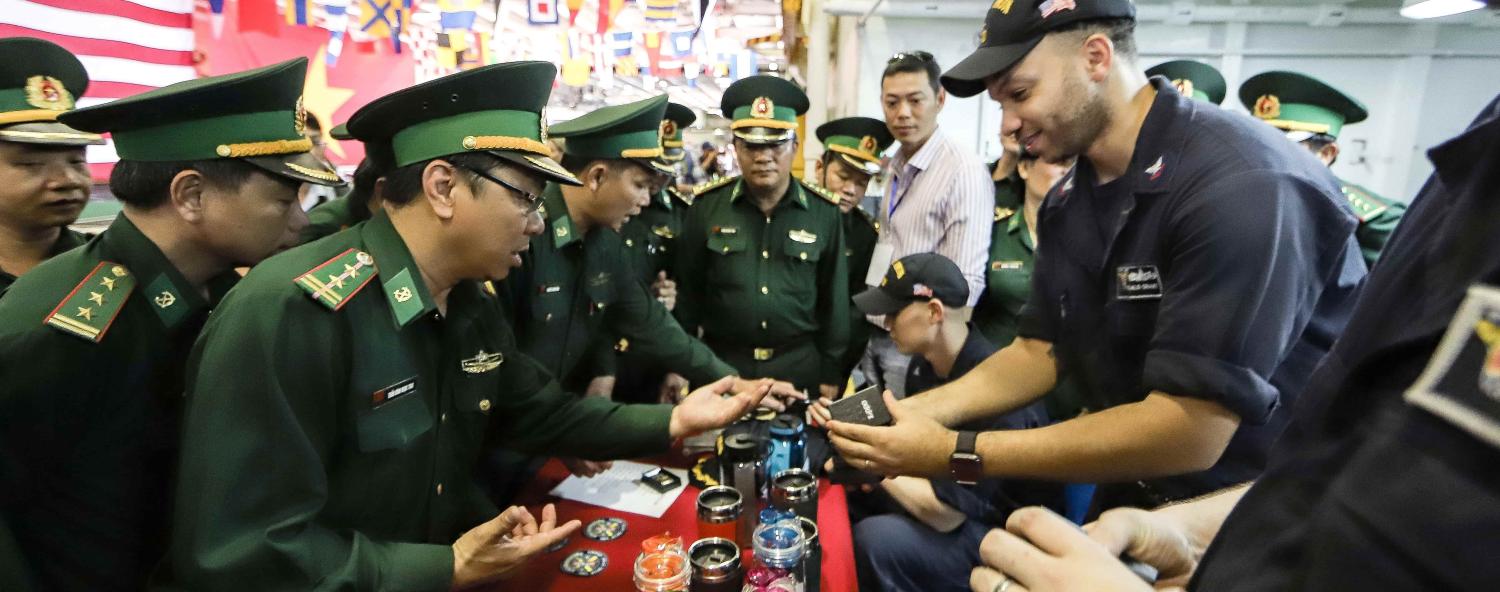On 5 March the USS Carl Vinson made a port call to Danang, in central Vietnam. It was the first time since the War (the Vietnam War to Americans, and the American War to Vietnamese) that a US aircraft carrier anchored in Vietnamese waters – by invitation this time – for an official visit.
The Carl Vinson’s visit reminds us that compared to Vietnam’s centuries-old efforts to balance against Chinese power, its antagonism with the United States was comparatively short-lived. And Hanoi’s desire for deterrent power to manage its strategic uncertainty involves new friends and old foes.
Two challenges
The setting of Vietnam’s military posture has long been conducted in the shadows of superpowers. Over the past 30 years, it has faced two major challenges: the collapse of the Soviet Union and China’s rising military power. Although these two developments took place during different generations of Vietnamese leadership, both loom large in Hanoi’s defence planning.
Like most Communist countries during the Cold War, Vietnam received large transfers of Soviet military aid. Due to Vietnam’s geostrategic environment, punctuated by the Sino-Vietnam War of 1979, Moscow chose to focus on strengthening Vietnam’s land force. Despite Vietnamese requests, the navy was relatively marginalised – no submarines were transferred to Hanoi from the Soviet Union.
After the termination of Soviet aid in 1992, Vietnam’s economy made a painful transformation under the Doi Moi policy, and maintenance of existing assets became a heavy burden. Thanks to the achievement of economic reform, resources for modernisation became available in the mid-1990s. The distribution of resources would come to be determined by another external factor – China.
In the 1990s, the previously hostile bilateral relations between Hanoi and Beijing improved following the settlement of their land borders and the maritime border in the Gulf of Tonkin. But while political relations warmed, China’s People’s Liberation Army was rapidly modernising, leaving its Vietnamese counterpart inferior and outdated.
Contested maritime territorial claims are the most likely cause of Sino-Vietnamese conflict. Hanoi currently concentrates its resources on the modernisation of naval and aerial capabilities. This has been the case for a decade now. Between 2008 and 2012 Vietnam concluded major arms deals of submarines, frigates, and fighters, among other assets, from Russia, Canada, the Netherlands, the United States, and Japan. But Beijing’s adventurism in the South China Sea (East Sea for Vietnam) from the late 2000s was clearly a factor in Hanoi’s renewed focus on maritime strategy and increased investment in its navy and air force.
One dilemma
Following the acquisition of those sophisticated maritime and aerial assets, Vietnam’s position in the South China Sea vis-à-vis China’s is less vulnerable than before. But the uneven approach to modernisation may nevertheless pose a dilemma in Hanoi: should Vietnam continue to concentrate investment on its navy and air force, or invest in its army?
The assets of the Vietnamese Army are a Cold War time capsule, having been neglected due to the low possibility of land warfare. A Chinese land invasion cannot be totally ruled out, but it is hard to imagine China breaking signed border treaties and risking a response from other powers in Asia.
Hanoi still retains a layered territorial defence system comprised of regular troops, border guards, and militia. However, without substantial renewal, the Vietnamese army’s increasing inferiority compared to its Chinese counterpart would be a big strategic risk for Vietnam to assume. Beijing could expose Vietnamese vulnerabilities and ill-preparedness through deployments and exercises close to the border, without rising to open conflict. Modernisation of the Vietnamese People’s Army would provide some deterrent effect.
Vietnam’s naval and air power may not be sufficient for East Sea / South China Sea contingencies. Hanoi lacks the resources to compete directly with the Chinese Southern Theater Command. And Beijing’s military deployments on its newly constructed artificial islands increases the pressure on Hanoi’s strategic position.
But Beijing’s geostrategic ambitions don’t allow for a concentration of forces, so Hanoi has worked to strengthen relations with New Delhi, Tokyo, and Washington. The most publicised example of this was President Barack Obama’s lifting of the US embargo on the sale of lethal weapons to Vietnam in 2016. And in November 2017, Vietnam signed a Strategic Partnership with Australia. Whether these non-alliance relations will have the desired deterrent effect is uncertain, and Vietnam’s interests in the South China Sea are complicated by Philippines President Rodrigo Duterte’s unwillingness to counter Chinese adventurism.
Despite impressive economic growth in the past three decades, Vietnamese decision makers lack the resources to satisfy both land and maritime military modernisation, and sorely needed domestic infrastructure projects also compete for funding.
Improving Vietnam–US relations would present more alternatives to replace the Vietnam military’s Soviet legacy, particularly in maritime surveillance, but it will not help to lessen Vietnam’s financial burden.
Vietnam’s defence posture faces a difficult future, with history weighing heavily on decision makers. With growing evidence of intensifying US–China competition, Vietnam’s defence policy will once again be made under the scrutiny of competing superpowers.

